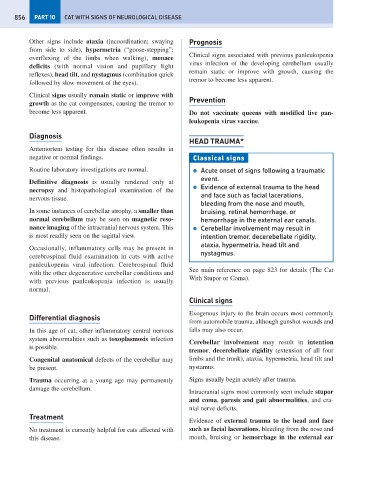Page 864 - Problem-Based Feline Medicine
P. 864
856 PART 10 CAT WITH SIGNS OF NEUROLOGICAL DISEASE
Other signs include ataxia (incoordination; swaying Prognosis
from side to side), hypermetria (“goose-stepping”;
Clinical signs associated with previous panleukopenia
overflexing of the limbs when walking), menace
virus infection of the developing cerebellum usually
deficits (with normal vision and pupillary light
remain static or improve with growth, causing the
reflexes), head tilt, and nystagmus (combination quick
tremor to become less apparent.
followed by slow movement of the eyes).
Clinical signs usually remain static or improve with
Prevention
growth as the cat compensates, causing the tremor to
become less apparent. Do not vaccinate queens with modified live pan-
leukopenia virus vaccine.
Diagnosis
HEAD TRAUMA*
Antemortem testing for this disease often results in
negative or normal findings. Classical signs
Routine laboratory investigations are normal. ● Acute onset of signs following a traumatic
event.
Definitive diagnosis is usually rendered only at
● Evidence of external trauma to the head
necropsy and histopathological examination of the
and face such as facial lacerations,
nervous tissue.
bleeding from the nose and mouth,
In some instances of cerebellar atrophy, a smaller than bruising, retinal hemorrhage, or
normal cerebellum may be seen on magnetic reso- hemorrhage in the external ear canals.
nance imaging of the intracranial nervous system. This ● Cerebellar involvement may result in
is most readily seen on the sagittal view. intention tremor, decerebellate rigidity,
ataxia, hypermetria, head tilt and
Occasionally, inflammatory cells may be present in
nystagmus.
cerebrospinal fluid examination in cats with active
panleukopenia viral infection. Cerebrospinal fluid
See main reference on page 823 for details (The Cat
with the other degenerative cerebellar conditions and
With Stupor or Coma).
with previous panleukopenia infection is usually
normal.
Clinical signs
Exogenous injury to the brain occurs most commonly
Differential diagnosis
from automobile trauma, although gunshot wounds and
In this age of cat, other inflammatory central nervous falls may also occur.
system abnormalities such as toxoplasmosis infection
Cerebellar involvement may result in intention
is possible.
tremor, decerebellate rigidity (extension of all four
Congenital anatomical defects of the cerebellar may limbs and the trunk), ataxia, hypermetria, head tilt and
be present. nystamus.
Trauma occurring at a young age may permanently Signs usually begin acutely after trauma.
damage the cerebellum.
Intracranial signs most commonly seen include stupor
and coma, paresis and gait abnormalities, and cra-
nial nerve deficits.
Treatment
Evidence of external trauma to the head and face
No treatment is currently helpful for cats affected with such as facial lacerations, bleeding from the nose and
this disease. mouth, bruising or hemorrhage in the external ear

